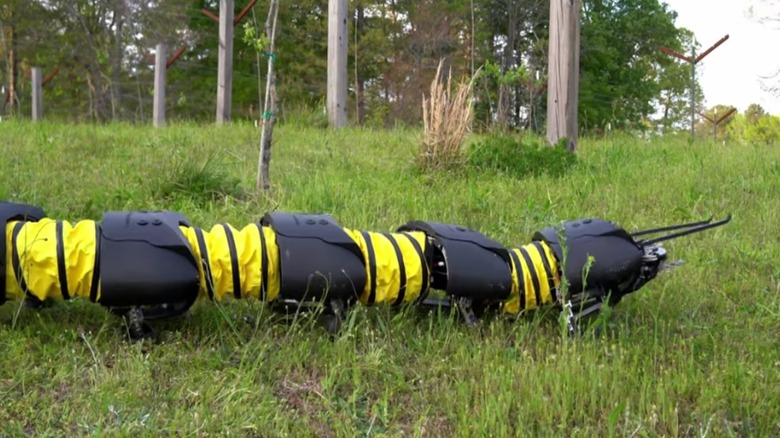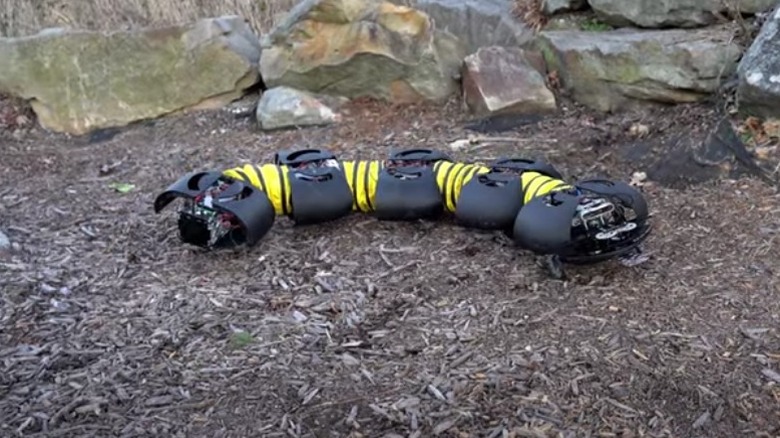Giant Centipede Robots Are Being Built For Farms: Here's The Reason
The world's biggest centipede, at potentially over 12 inches long, certainly earns the "giant" in Amazonian giant centipede. This particular species of minibeast has 42 legs, and while all centipede species are different in that regard, one thing they seemingly share in common is that they don't necessarily have the most practical design for a robot to be based on. Or so you might think. In a world that's constantly looking to avoid jobs by automating them, a many-legged centipede robot has been created that seems to have a bright future tending crops for us on farms.
Terrain can be a tricky thing for robots. An enterprising Roomba or Roborock's home cleaning companion, the Saros Z70, for instance, might handle the angles and slight inclines of a home just fine, but farmland, which could be grassy, muddy, stony, wet, or all these things simultaneously, would be rather too much of an ask. Meanwhile, the several sets of sturdy legs boasted by the centipede bots of Ground Control Robotics have a much better chance. The key to these remarkable-looking machines is their versatility in movement, with the Georgia Research Alliance noting that their limbs and segmented bodies allow for omnidirectional movement, and that the robots can even swim in moderately deep water.
Being maneuverable and low to the ground makes these centipedes potentially well suited to a role in a field that Ground Control Robotics dubs "specialty agriculture." It's difficult to get to the roots of certain plants without causing damage, and work by hand in such cases can be slow and impractical. Perhaps these little bug bots' weed-busting talents could be an effective solution to that issue.
How Ground Control Robotics' centipedes work
When designing a robot that resembles an animal, the crucial thing is to consider what that creature's biological design allows it to do, and how these things would be useful for the potential role of that robot. Ground Control Robotics notes that the centipede robots can right themselves effectively should they topple over, which, in tandem with sensors that allow it to avoid obstacles in its path, makes it well suited to the challenging terrain it would typically encounter.
Primarily designed as a tool to help care for plants that are pricey or difficult (or generally both) to manage, such as strawberries, or which inconveniently choose to grow on terrain that's equally challenging, it has some impressive features that support it in its efforts to do so. Aside from its capacity to right itself, avoiding having to spend too much of its two-hour battery life on its back, it also has to be able to tell the weeds it's supposed to eliminate from the plants it needs to lovingly care for. Fortunately, there's an AI algorithm for that. It can also remove weeds or pull them out using its mighty little mandibles (or the robotic equivalent of such).
It's also important to note, of course, that sophisticated target identification would be moot if the robot couldn't access the vital spot, which is one thing that's also very difficult for human workers. The good news is that it isn't simply a small design, but it's low to the ground and will remain so while moving. Military robots can do incredible things on the battlefield, and perhaps these little bug bots will do great things in their own milieu.
The potential applications of Ground Control Robotics' work
Speaking to IEEE Spectrum, Ground Control Robotics' Dan Goldman called the robots "experimental physics tools," spurning the notion that they were just making toys. They were designed for a functional application and seem well-equipped to do it. A group of caterpillar robots working in tandem (or a swarm, as the idea is defined by the company), if refined, could do a great job in its niche role, and could potentially expand beyond it. It not only has the potential, but it also has the enormous advantage that there isn't really another robot specialized for this specific job at present.
For now, we don't have herds of robotic centipedes tending our crops. They're starting small and have been working with businesses such as a blueberry farm in Georgia to gauge how the bots perform in what will be their home environment. While we don't yet know what the future holds for Ground Control Robotics, climate change would suggest that agriculture certainly isn't going to be getting any easier for humanity. Technology like this could be just what we need going forward. Robotic centipedes farming on Mars may sound like something out of a "Doctor Who" episode, but maybe the notion isn't that far-fetched at all. We've already seen farming robots using lasers as weed killers, after all.

